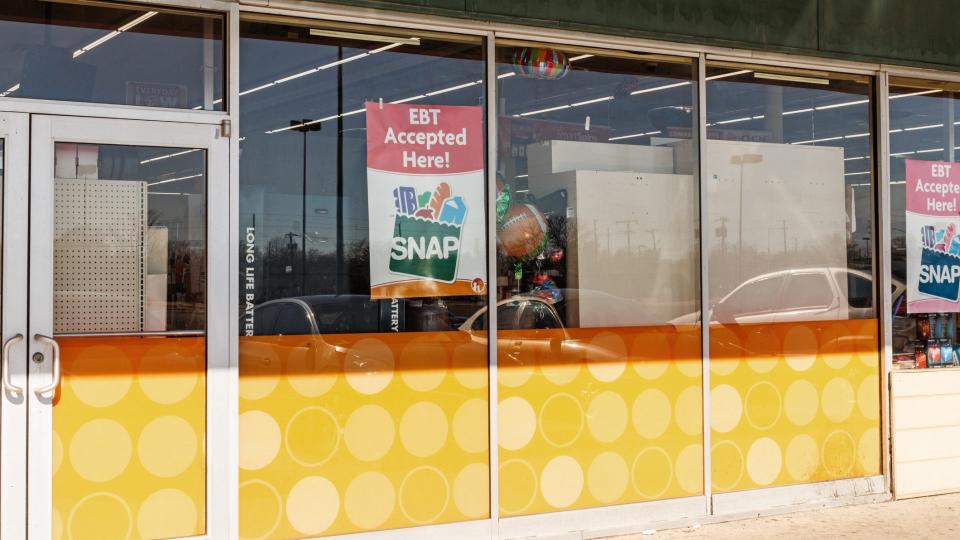Food Stamps: SNAP Cuts and Low Tax Returns Spell Disaster for Dollar General and Other Discount Retailers

Discount retail chains that depend on food stamp customers for a good chunk of their business are already bracing for a slowdown in sales tied to the recent end of emergency food stamp benefits.
See: What Is the Highest Income Level for Food Stamps in 2023?
Discover: 3 Signs You’re Serious About Raising Your Credit Score
Emergency allotments for food stamps — formally known as Supplemental Nutrition Assistance Program (SNAP) benefits — ended nationwide after Feb. 28. The allotments were originally approved during the COVID-19 pandemic and boosted the typical SNAP payment by $95 a month.
Thirty-two states stopped paying emergency allotments after Feb. 28, joining the 18 other states that ended the extra payments earlier. It’s a particularly tough time for SNAP recipients to have their benefits cut, as food prices remain high even amid a recent slowdown in the overall inflation rate.
With more of their budgets going toward essentials, many SNAP customers are expected to slow their spending in other areas. This does not bode well for Dollar General and other discount retailers.
As Business Insider reported, most of Dollar General’s stores are located in rural communities where customers are “increasingly economically strained,” President and CFO John Garratt said during a call with investors last week.
“It’s possible that this could further pressure the low-income customer somewhat in the near-term,” Garratt added. “We didn’t see an impact last year. Some rolled off. But the customer is in a different place now.”
Other discount retailers bracing for a slowdown include off-price department chain Burlington and value chain Big Lots.
“We remain concerned about the lower-income customer, our core customer,” Burlington CEO Michael O’Sullivan said during a call with investors earlier this month. “In 2022, this customer group bore the brunt of the impact of inflation on real household incomes. We think the impact of inflation will moderate this year, but there are other factors that could hurt this customer, such as a rise in unemployment and the ending of expanded SNAP benefits.”
Similarly, Big Lots customers are “pinched,” CEO Bruce Thorn said during a recent investor call. “At this point, 30% of that lower household income customer, their expenses today are greater than their income coming in. And 70% of them have curbed spending as a result of that.”
Because SNAP provides food-purchasing assistance to low-income U.S. households, many beneficiaries shop at discount stores to make their money stretch further. Food stamps account for more than 10% of overall dollar-store revenues and can contribute more than one-fifth of overall supermarket sales in lower-income areas, Fox Business reported, citing comments from Howard Jackson, president of the retail advisory firm HSA Consulting.
As GOBankingRates previously reported, research conducted by IRI found that before the pandemic, SNAP recipients accounted for roughly 12% of all food and beverage sales online and in stores at major chains. During the first year of the pandemic, SNAP shoppers drove 19% of dollar growth for food and beverage retailers — mainly because of the emergency allotments.
With SNAP recipients losing the extra money they got during the pandemic, grocery sales at many retailers are likely to take a hit. In fact, this has already happened. During the fiscal quarter ended in August 2022, supermarkets in eight states that already ended emergency allotments underperformed those in the 38 states that still paid the allotments, according to a report from BMO Capital Markets.
Once you factor in 2023 cost-of-living increases for SNAP benefits, Goldman Sachs analysts expect overall SNAP benefits to decline 7% this year compared with last year. That will end at least three consecutive years of growth, Fox Business noted.
Of the companies that Goldman Sachs analyzed, bargain retailer Grocery Outlet had the highest exposure to SNAP, at about 15% of total sales in 2021. Others with high exposure include Walmart, Dollar General, Family Dollar, Kroger and BJ’s Wholesale Club. Each of those chains got nearly 10% of revenue from food stamps.
Some of the lost SNAP revenue will be recovered through sales to higher-income consumers who have gravitated to discount stores to offset high inflation. Another positive trend is the low unemployment rate, which should make it easier for low-income individuals to find work and boost their earnings.
Take Our Poll: What Do You Plan To Use Your Tax Refund For?
Dollar Tree: 5 High-Quality Items To Buy Now
Even so, some retail experts expect discount chains to suffer from lower SNAP-related sales because they operate with such thin margins.
“It is difficult in this very low margin business to develop capital and sustain a business without outside support,” Stephanie Johnson, vice president of government relations for the National Grocers Association (NGA), said in a letter to Congress.
More From GOBankingRates
This article originally appeared on GOBankingRates.com: Food Stamps: SNAP Cuts and Low Tax Returns Spell Disaster for Dollar General and Other Discount Retailers

 Yahoo Finance
Yahoo Finance 